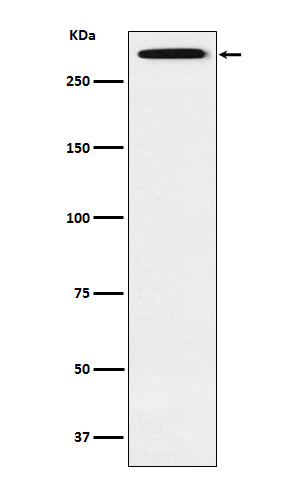Smg1 Rabbit mAb [u38l]Cat NO.: A70743
Western blot(SDS PAGE) analysis of extracts from Saos2 cell lysate.Using Smg1 Rabbit mAb [u38l]at dilution of 1:1000 incubated at 4℃ over night.
Product information
Protein names :61E3.4; ATX; hSMG1; LIP; smg1;
UniProtID :Q96Q15
MASS(da) :410,501
MW(kDa) :410kDa
Form :Liquid
Purification :Affinity-chromatography
Host :Rabbit
Isotype : IgG
sensitivity :Endogenous
Reactivity :Human,Mouse,Rat
- ApplicationDilution
- 免疫印迹(WB)1:1000-2000
- The optimal dilutions should be determined by the end user
Specificity :Antibody is produced by immunizing animals with A synthesized peptide derived from human Smg1
Storage :Antibody store in 10 mM PBS, 0.5mg/ml BSA, 50% glycerol. Shipped at 4°C. Store at-20°C or -80°C. Products are valid for one natural year of receipt.Avoid repeated freeze / thaw cycles.
WB Positive detected :Saos2 cell lysate.
Function : Serine/threonine protein kinase involved in both mRNA surveillance and genotoxic stress response pathways. Recognizes the substrate consensus sequence [ST]-Q. Plays a central role in nonsense-mediated decay (NMD) of mRNAs containing premature stop codons by phosphorylating UPF1/RENT1. Recruited by release factors to stalled ribosomes together with SMG8 and SMG9 (forming the SMG1C protein kinase complex), and UPF1 to form the transient SURF (SMG1-UPF1-eRF1-eRF3) complex. In EJC-dependent NMD, the SURF complex associates with the exon junction complex (EJC) through UPF2 and allows the formation of an UPF1-UPF2-UPF3 surveillance complex which is believed to activate NMD. Also acts as a genotoxic stress-activated protein kinase that displays some functional overlap with ATM. Can phosphorylate p53/TP53 and is required for optimal p53/TP53 activation after cellular exposure to genotoxic stress. Its depletion leads to spontaneous DNA damage and increased sensitivity to ionizing radiation (IR). May activate PRKCI but not PRKCZ..
Tissue specificity :Widely expressed, with highest level in heart and skeletal muscle. Expressed in placenta, brain, lung and spleen, but not in liver..
Subcellular locationi :Nucleus. Cytoplasm.
IMPORTANT: For western blots, incubate membrane with diluted primary antibody in 1% w/v BSA, 1X TBST at 4°C overnight.


